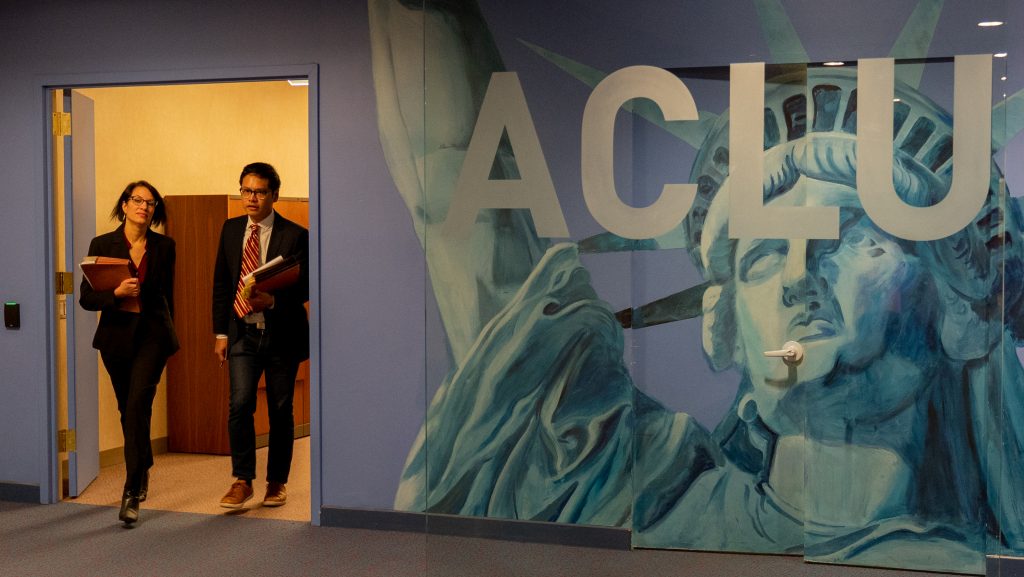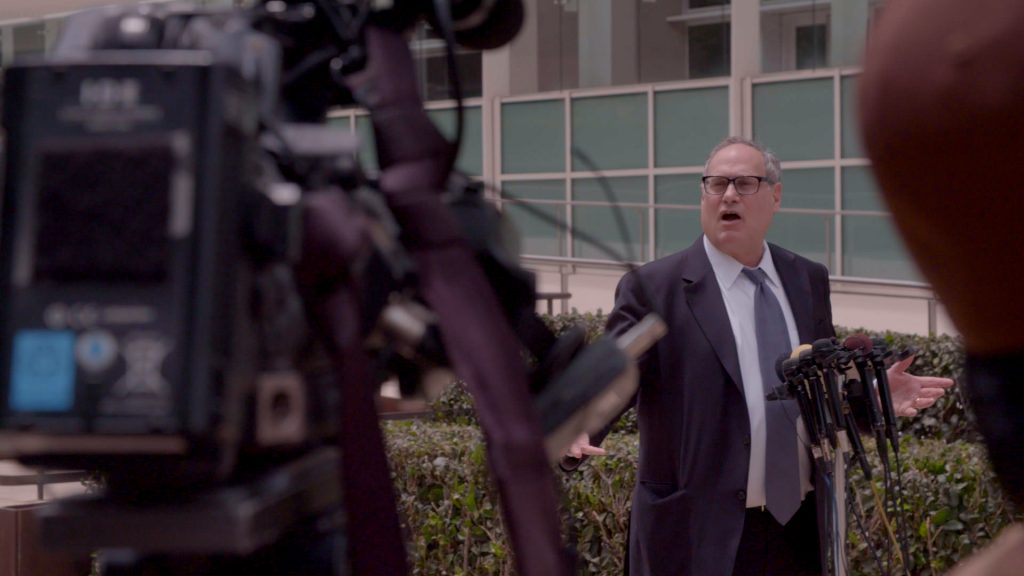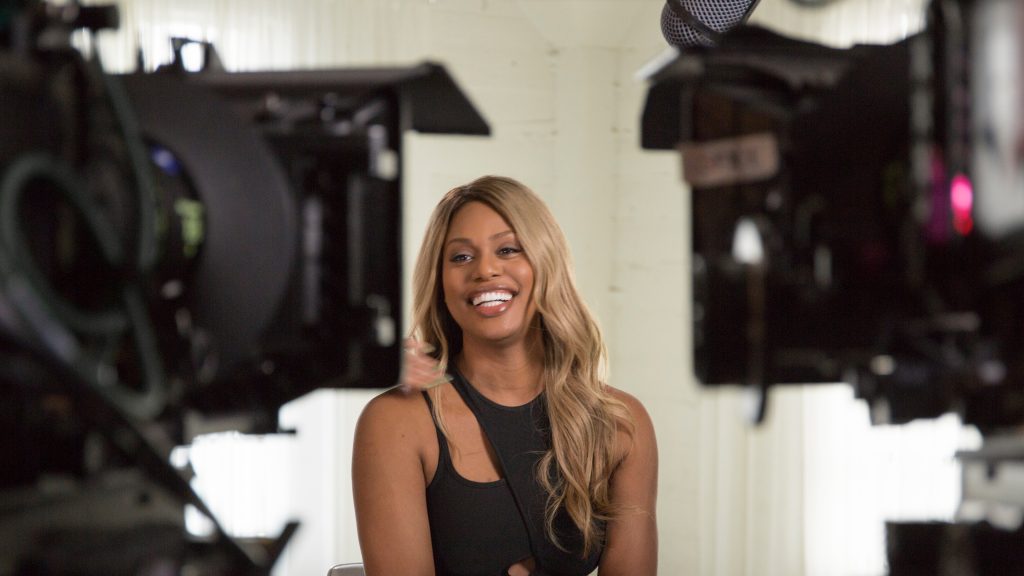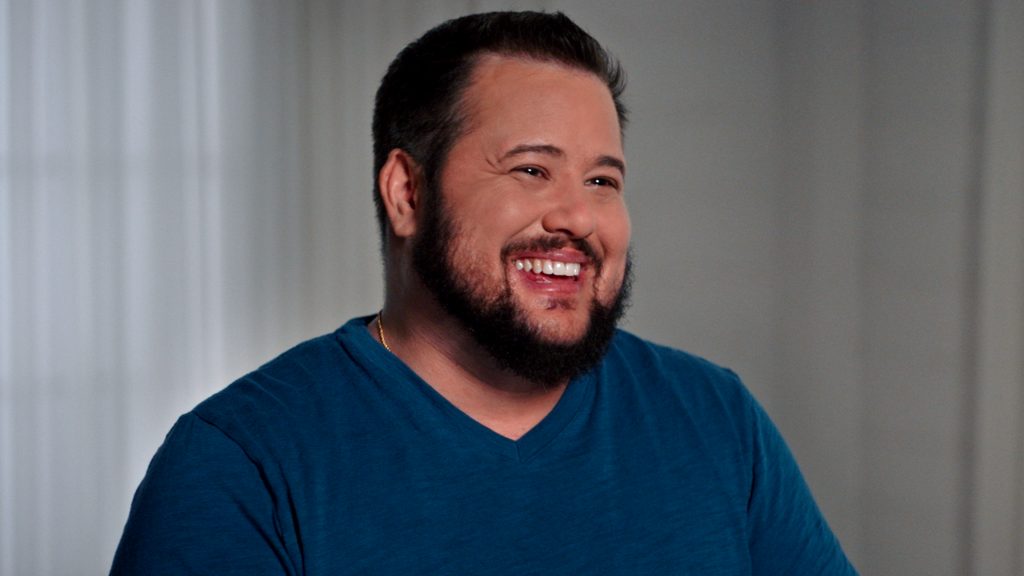July 31, 2020
by Carla Hay

Directed by Elyse Steinberg, Joshua Kriegman and Eli Despres
Culture Representation: This documentary about the New York City-based American Civil Liberties Union (ACLU) features a predominantly white group of people (with some Asians, Latinos and black people), as the movie follows five ACLU attorneys in their battles for civil rights.
Culture Clash: The movie (which began filming shortly after Donald Trump was inaugurated as president of the United States in 2017) focuses on four main issues that ACLU is fighting against with the Trump administration: immigrants’ rights, reproductive rights, voting rights and LGBTQ rights.
Culture Audience: “The Fight” will appeal primarily to people who have liberal political views and/or support what the ACLU is doing.

The documentary “The Fight” takes a behind-the scenes look at some of the legal battles waged by the New York City-based American Civil Liberties Union (ACLU) shortly after Donald Trump was inaugurated as president of the United States in January 2017. Although the legal issues aren’t new, the documentary shows that Trump’s attempts as president to make sweeping changes to civil-rights laws brought increased urgency for the ACLU to fight back against those attempts.
“The Fight” co-directors Elyse Steinberg, Joshua Kriegman and Eli Despres had unprecedented access to ACLU headquarters as well as high-ranking members of the ACLU team. The movie focuses on five attorneys with four different specialties: Lee Gelernt (immigrants’ rights); Brigitte Amiri (reproductive rights); Dale Ho (voting rights); and Josh Block and Chase Strangio (LGBTQ rights).
Each of these four issues is given a spotlight, as the featured ACLU attorneys prepare legal cases that represent these causes. Cameras are not allowed in the courtrooms for these cases, but what happens on the inside of these courtrooms is depicted in the film through audio recordings, illustrations and animation.
Gelernt is involved in battling Trump’s order to banning immigrants from several Muslim-majority countries, as well as the controversy over immigrants seeking refugee status in the U.S. and being locked up and separated from their children. He is he deputy director of the ACLU’s national Immigrants’ Rights Project and director of the project’s Access to the Court’s Program. In the documentary (where almost all of the clients’ full names are not disclosed, for privacy reasons), Gelernt is shown helping an African immigrant woman identified only as “Mrs. L” in her case against U.S. Immigration and Customs Enforcement’s (ICE) because she was separated from her 7-year-old daughter, who was sent to live in Chicago without Mrs. L’s permission.
ACLU Reproductive Freedom Project deputy director Amiri fights back in cases involving abortion restrictions that the ACLU believes are unconstitutional policies against the U.S. Supreme Court case Roe v. Wade, which made abortion legal in all U.S. states in 1973. Amiri, with the help of ACLU reproductive rights attorney Meagan Burrows, is shown helping a 17-year-old Spanish-speaking pregnant immigrant in the case Garza v. Hargan.
The immigrant, who is identified only as “Jane Doe” in the documentary, says that her pregnancy was due to rape, and she wants an abortion, but is being prevented from getting an abortion by the Office of Refugee Resettlement (ORR), which she says is treating her like a prisoner. In an interview with Spanish, she says that ORR officials won’t let her outside, they follow her into the bathroom, and they won’t let her visit a doctor. The outcome of her case is a race against time, because in the U.S. state where she lives, abortion is illegal when a pregnancy reaches at least 20 weeks, and Jane Doe’s interview in the documentary was when she was 15 weeks pregnant.
ORR director Scott Lloyd, an admitted right-wing conservative, is the ACLU’s chief nemesis in this case, since he’s the official who signed off on Jane Doe not being able to have an abortion. Lloyd is seen squirming and being evasive in a videotaped deposition when asked what his views are on abortion. But later in the documentary there is TV footage of him appearing on a conservative talk show openly discussing that he is a conservative Christian who thinks abortion should not be legal.
ACLU Voting Rights Project director Ho does a lot of work against voter suppression. But the main battle that he has in the documentary is the case Department of Commerce v. New York, which is the ACLU’s fight to prevent any questions from being added to the 2020 U.S. Census that asks if anyone in a U.S. household is a U.S. citizen. The ACLU and other civil-rights groups have a legal argument that this question about U.S. citizenship is unconstitutional for a U.S. census, because the question is designed to deter people from filling out a census form if they are not U.S. citizens or have people in their households who aren’t U.S. citizens, thereby making them underrepresented in the census.
Block (an openly gay cisgender male) and Strangio (an openly transgender male) work as a team. Block is a senior staff attorney with the National ACLU’s Lesbian Gay Bisexual Transgender & HIV Projects. Strangio (who is a parent to a daughter, who’s shown in the documentary) is deputy director for Transgender Justice with the ACLU’s LGBT & HIV Project. Block and Strangio are seen working on the case Stone v. Trump, in reaction to Trump wanting to ban transgender people from the U.S. military. In this case, the ACLU is representing transgender male plaintiff Brock Stone, a U.S. Navy petty officer first class who has been in the Navy since 2006.
The directing style of the documentary is cinéma vérité, with each of the narrative jumping back and forth between each case. There is ample use of a split-screen format (with three or four screens at once) to show what might be happening on multiple cases. However, all of this doesn’t get confusing because the cases and the lawyers are very distinct from each other, and everything is smoothly edited to together in a cohesive storytelling style.
And fortunately, the documentary isn’t cluttered with a lot of interviews with people who aren’t involved in the cases, because those outside people would be a distraction and could possibly compromise some of the confidentiality of any pending cases at the time. Other ACLU employees who are briefly featured in the documentary include ACLU executive director Anthony Romero and ACLU deputy director of communications Stacy Sullivan.
On the flip side, the documentary doesn’t shut out opposing views of the ACLU. There is some archival footage of ACLU opponents getting into debates with ACLU attorneys on TV talk shows (usually on cable news channels), as well as news footage of Trump and his supporters at Trump rallies and speeches. And the documentary briefly includes other examples of the ACLU representing people or groups that promote hate speech and other controversial issues that the ACLU says that people have a right to express under freedom of speech.
There’s also a segment in “The Fight” where all of the featured attorneys read aloud or show many of the hate messages that they get (on social media, by mail or by phone), because of the work that they do for the ACLU. Many of the haters identify themselves as Trump supporters, and the ACLU lawyers who aren’t straight white men are often called racist, sexist or homophobic slurs.
Gelernt says of the hateful criticism that often includes death threats or other threats to his safety: “If you don’t look at the negative stuff, you’re sort of in your own bubble.” Ho comments on being the target of ACLU haters: “I don’t want to run from this,” as he says as he takes a hate-filled postcard that he got in the mail and tacks the postcard on his office wall.
The documentary also includes an unflinching look at how there can be conflicts within the ACLU. The ACLU won a lawsuit for a Unite the Right protest (consisting of white supremacists) to be held on the streets of Charlottesville, Virginia, on August 11 and August 12, 2017. That rally led to tragedy, when a Unite the Right supporter plowed his car through counterprotesters, killing 32-year-old counterprotester Heather Heyer.
Although some people blamed the ACLU for this tragedy, others did not. And the documentary shows that people in the ACLU also had different opinions on how the ACLU’s legal defense for the Unite the Right protest to take place ended up playing a role in this tragedy. The documentary does not show anyone at the ACLU getting into heated debates about this protest, but the film does offer two different points of view from high-ranking ACLU officials.
ACLU director David Cole (a white man) stands firm in his belief that the ACLU did the right thing in helping make the Unite the Right protest happen: “We defend civil liberties for all,” he says in the documentary. Meanwhile, ACLU deputy legal director Jeffrey Robinson (an African American man) says that privately, he had a problem with the ACLU being involved in making the Unite to Right rally happen, and he did not support ACLU’s decision to represent the Unite the Right people in their legal case to make the protest happen. Robinson comments in what was obviously a prepared statement: “The ACLU was not responsible for Heather Heyer’s death, but we were not a random organization just watching what happened.”
The documentary does a good job of making the featured attorneys look very human. The attorneys are all shown with family members (Gelernt, Amiri and Ho are married with children) and with getting emotional during the many ups and downs in their cases. They all show empathy for their clients. And they all talk about the toll that their stressful work takes on their personal lives and emotional health. However, none of them wants to quit because they say that the work is too important to them.
They attorneys aren’t afraid to show their insecurities: Block wants Strangio to take the lead on the Stone v. Trump case, because Strangio is transgender, but Strangio declines to do so because he says that he’s still not comfortable standing up in court and making arguments. Ho is the lawyer who tends get gets tongue-tied and flustered the most. Gelernt talks about feeling that if he loses a case, he will let down not just his client but also American society. (All ACLU attorneys probably feel this way too.)
But not everything is dead-serious in the film. There are touches of humor, such Gelernt (the oldest lawyer in the documentary’s featured five) getting flustered when he doesn’t know how to plug a phone charger into a computer. Each of the attorneys give a tour of the ACLU offices in their own unique style, and during his tour Gelernt admits that he doesn’t even know how to use the copy machine.
Meanwhile, Block is shown going from pleased to frustrated when he uses a dictation program on his computer. Things starts out fine but then the computer program’s translation abilities quickly goes awry, in one of the funnier scenes in the film. Ho is shown in multiple scenes practicing his courtroom arguments in front of a mirror, sometimes with amusing results.
Of the legal cases featured in “The Fight,” most of the outcomes are already known. However, just because there have been rulings on these cases (some of which were appealed), that doesn’t dilute a lot of gripping suspense and emotionally stirring moments in the documentary, since it shows for the first time many of the behind-the-scenes, real-time reactions that the ACLU people had to major steps in the cases.
The ACLU is celebrating its 100th anniversary in 2020, so “The Fight” is a fitting tribute to the legacy and longevity of the ACLU. But as Ho says in the documentary, the ACLU should not be counted on as the only way to defend liberties for everyone, when there are forces trying to take away or restrict those freedoms. “It’s not going to be lawyers in courts,” he comments on who will be making the most progress. “It’s going to be people [in the general public] turning the ship around.”
“The Fight” probably won’t change a lot of people’s political opinions. Trump’s views on issues such as immigration and abortion were made very clear during his presidential campaign, so people who voted for him in 2016 expected him to act on those views. However, for anyone interested in what politically liberal attorneys at the ACLU are doing behind the scenes to push back against many of the changes that Trump and politically conservative lawmakers want for the United States, “The Fight” offers an insightful peek into this process.
Magnolia Pictures and Topic Studios released “The Fight” in select U.S. virtual cinemas, on digital and on VOD on July 31, 2020.


